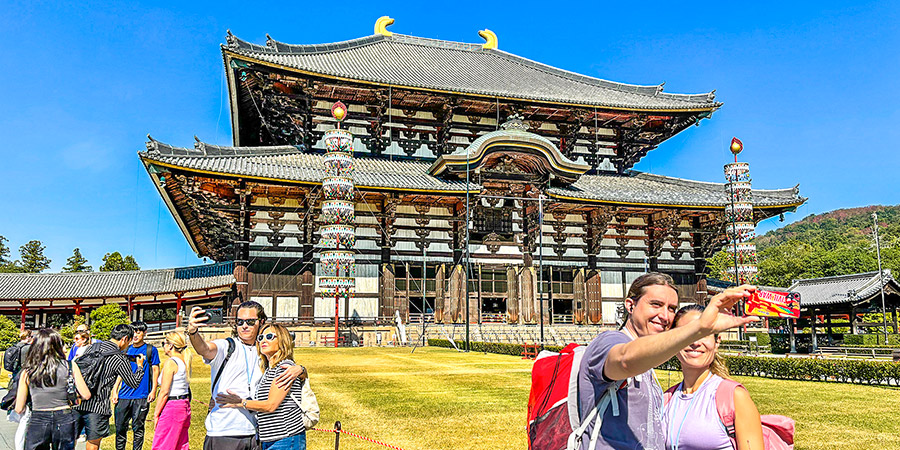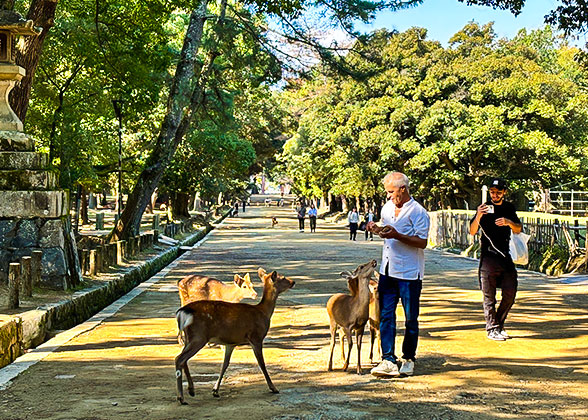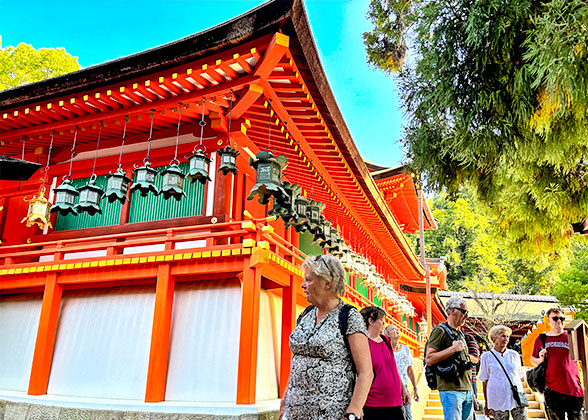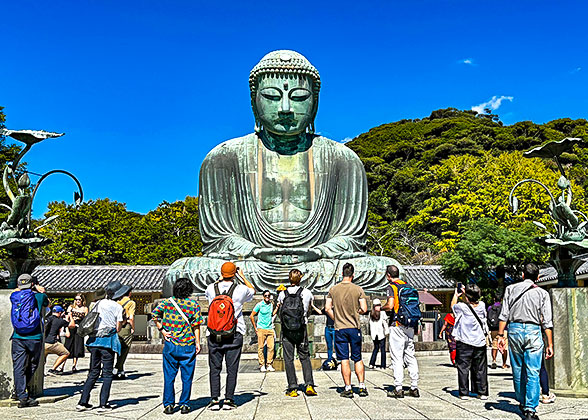Todaiji Temple
Todaiji Temple is one of the most treasured historical sites in Nara Park and even the whole world because it hosts the biggest wooden structure and the biggest Bronze statue in the world. If you visit Nara, Todaiji Temple is an unmissable attraction. Besides, you can see abundant Japanese national treasures inside the temple, many of which are from thousands years ago.

Todaiji Temple Photos ( 20
|
You also can see many deer roaming in the temple, and they will bow to you for food. If you do not have any food, you can bow to deer; then they may leave you. Some deer may attack humans, so do not tease them, especially little deer. What’s more, it is necessary to hide your food, otherwise deer might keep nipping at your clothes. You won't regret spending 1.5 hours exploring ancient buildings and feeding deer.
Must-sees in Todaiji Temple
1. The Great Buddha Hall
The current Great Buddha Hall was established in 1709 and is the largest wooden structure in the world. The original hall was 88 meters (288 feet) long, and now the hall is 57 meters (187 feet) long, 50 meters (164 feet) wide, and 48 meters (157 feet) high.
|
|
In addition, there is a very thick pillar with a big hole behind the right side of the big Buddha. It is said that as long as you go through the hole, you can ward off diseases and disasters, so there are always crowds of people around the pillar, especially children. Besides, since the Buddha Rushanabutsu stands for truth and wisdom, many parents let their children climb through the hole to gain wisdom. The hole is 37 cm (1.2 feet) high, 30 cm (0.98 feet) wide, and 110 cm (3.6 feet) long. You’d better decide whether to go through the hole or not based on your size to avoid an embarrassing situation.

Golden Bodhisattva besides
|
2. Huge Great South Gate
Great South Gate is the front gate of Todaiji and the biggest temple gate in Japan. The gate is about 25 meters (82 feet) high. You can see many stout and huge wooden pillars supporting the gate. Many visitors choose to take contrast photos with these huge pillars. Besides, tourists can see two big wooden statues with exaggerated expressions and strong muscles, which are about 8 meters (26 feet) at the gate. Being exposed to the wind and sun for long, the red paint on the wood structure has faded away.
|
|
|
3. Nigatsu-dō

Todaiji Temple in Autumn
|
4. Todaiji Museum
The museum was opened in 2011, and it contains five exhibition rooms. You can learn about the history and background of Todaiji Temple. At the gate of the museum, you can see a pair of huge hands, which are the same size as the Todaiji Big Buddha's palms. It is a good choice to learn some knowledge about Todaiji Temple in the museum.5. Hokke-dō and Kaidan-dō
Hokke-dō is the oldest building in Todaiji Temple and was established between 740 and 747. Fukūkensaku Kannon statue is the main Buddhist statue in it. Besides, you also see other treasured Buddha statues inside.Kaidan-dō hosts the Buddhist statues of The Four Divine Kings. The four figures can protect people from the harm of evil spirits. You can see that every statue of Buddha has an evil spirit at its feet.
|
|
|
Visit Tips
1. Todaiji Temple offers varied Goshuin stamps for stamp collectors. A Goshuin stamp is 300 yen.2. Todaiji Temple sometimes provides free explanation services to help visitors know about the structure of the hall, the history of the temple, and so on. You can consult the staff of Todaiji Temple.
3. Smoking, sketching, and drone photography are prohibited in Todaiji.
4. You are not allowed to use a flashlight when get into the halls.
5. Watch your sleeves when firing incense sticks.
Opening Time
|
|
April to October |
November to March |
|
Great Buddha Hall |
7:30 – 17:30 |
8:00 – 17:00 |
|
Todaiji Museum |
09:30 – 17:30 |
9:30 – 17:00 |
|
Hokke-dō |
8:30 – 16:00 |
|
|
Kaidan-dō |
||
Ticket
1. The Great Buddha Hall, Hokke-dō, Kaidan-dō, and Tōdaiji Museum all are charged 800 yen respectively.2. Children between 6 and 12 years old are charged 400 yen respectively for each ticket.
3. Combo ticket is 1,200 yen, and it contains Buddhist Hall and Todaiji Exhibition Hall.
How to Get to Todaiji Temple
1. You can take the JR Nara Line to JR Nara station, change to the Nara Bus and get off at the “Tōdai-ji Daibutsuden / Kasuga Taisha-mae” bus station, then you only need to walk for about 5 minutes.2. You can take the Kintetsu Nara Line, and get off at Kintetsu Nara station. Then, take the Nara city circulation Bus at Kintetsu Nara station, and get off at “Tōdai-ji Daibutsuden / Kasuga Taisha-mae”. Besides, you can take the round bus at Kintetsu Nara Station, and get off at “Daibutsuden-mae Parking Lot”.
See more:
Travel Advice
Todaiji Temple is one of the attractions in Nara Park. After visiting the temple, it is worth taking time to visit other attractions inside, such as Mountain Wakakusa, Kasuga Taisha Shrine, Nara National Museum, Isuien Garden, Himuro Shrine and Kofukuji Temple.You May Like
-
 7 Days Best Japan Private Tour of Tokyo - Mt. Fuji - Tokyo - Kyoto - Nara - Osaka from USD2401
7 Days Best Japan Private Tour of Tokyo - Mt. Fuji - Tokyo - Kyoto - Nara - Osaka from USD2401 -
 11 Days Mini Group Tour to Tokyo - Hakone (Mt. Fuji) - Kyoto - Nara - Osaka - Hiroshima - Kanazawa - Shirakawa-go - Takayama - Tokyo from USD3554
11 Days Mini Group Tour to Tokyo - Hakone (Mt. Fuji) - Kyoto - Nara - Osaka - Hiroshima - Kanazawa - Shirakawa-go - Takayama - Tokyo from USD3554 -
 13 Days Japan Private Tour of Tokyo - Kamakura - Tokyo - Mt. Fuji - Kyoto - Nara - Hiroshima - Osaka from USD4443
13 Days Japan Private Tour of Tokyo - Kamakura - Tokyo - Mt. Fuji - Kyoto - Nara - Hiroshima - Osaka from USD4443

